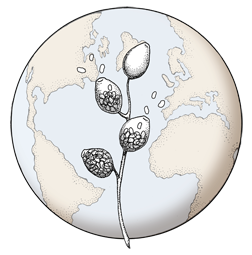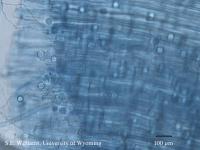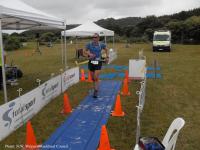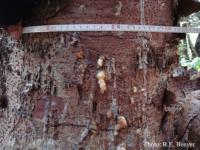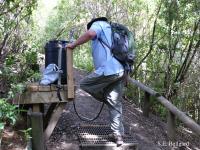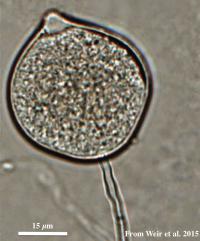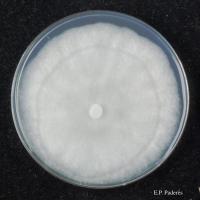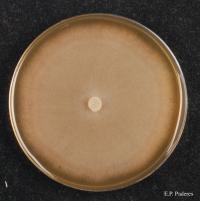Oospores in the roots of kauri seedlings inoculated with P. agathidicida. The root has been cleared with potassium hydroxide and bleached with peroxide before being stained with trypan blue (scale bar =100 µm).
Photo Gallery
|
P. agathidicida oospores in planta |
Tāne Mahuta “Lord of the Forest” kauri tree Tāne Mahuta “Lord of the Forest” is a giant kauri tree (approximately 47 metres in height) in the Waipoua Forest of Northland Region, New Zealand. Its age is unknown but is estimated to be between 1,250 and 2,500 years |
P. agathidicia oogonia P. agathidicida oogonia with SEM (top) and light microscopy (bottom) |
|
Mat to control spread of P. agathidicida Jogger running over a plastic-reinforced, foam-mat containing a 2% solution of Trigene™ Advance (quaternary ammonium compound) as part of a cross-country event, in the Waitakere Regional Park |
P. agathidicida lesion on kauri tree Close up of gum oozing out of lower trunk lesions of a young kauri tree at Maungaroa Ridge, Piha region of Waitakere Regional Park |
P. agathidicida growth on CMA Diffuse, non-patterned, colony morphology of ICMP 16471 (the original “Gadgil isolate”) after 10-days incubation at 20°C in the dark |
|
P. agathadicida disease symptom Excavated lesion, with outer bark removed showing extent of disease-front |
Boot wash to station to control spread of P. agathidicida Use of hypochlorite solution applied through a “livestock drench-gun”, integrated with a soil grate to allow potentially contaminated soil to be collected |
Comparative gametangial morphology of Phytophthora Clade 5 species Comparative gametangial morphology of Phytophthora Clade 5 species, with SEM (top) and light microscopy (bottom). P. heveae has smooth walled oogonia with funnel-shaped, amphigynous antheridia. P. agathidicida has mildly stipulate oogonia with globose amphigynous antheridia. P.cocois has mildly bullate oogonia with reflexed amphigynous antheridia. P. castaneae has coarsely bullate oogonium with rugose protuberances and narrow amphigynous antheridia (Weir et al. 2015). |
|
P. agathidicida sporangium Globose to ovoid-ellipsoid, papillate sporangium |
P. agathidicia growth on PDA Colony morphology of ex-holotype ICMP 17027 after 10-days incubation at 20°C in the dark |
P. agathidicida growth on MEA Diffuse, non-patterned, colony morphology of ICMP 16471 (the original “Gadgil isolate”) after 10-days incubation at 20°C in the dark |

